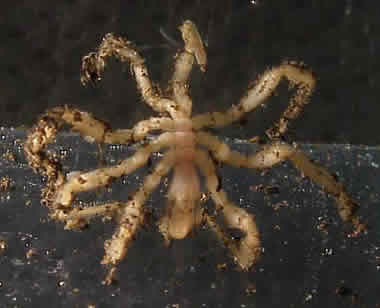

ENDEAVOUR HYPOTHERMAL VENTS

Sea Spider (Sericosura venticola), endemic to Endeavour Hypothermal Vents. Photo by Verena Tunnicliffe (public domain photo).
Deep sea habitats contribute significantly to the biodiversity of British Columbia. The Endeavor Hypothermal Vents Marine Protected Area is a deep sea habitat that is highly significant. It is located in the offshore waters of the northeast Pacific, 256 km southwest of Vancouver Island, and is found at a depth of 2200 m. It includes large hot black smokers (sea vents) (temperature >300C), chimney-like structures, and surrounding lower temperature sites {<115C) that contribute to the diversity and uniqueness of the site (DFO 2008). Tunnicliffe and Thomson (1999) describe this site:
"The Endeavour Hot Vents Area is part of the Juan de Fuca Ridge. This ridge comprises seven segments. The ridge is a seafloor spreading zone where new rock is formed and spreads to each side of the ridgecrest. This process pushes the huge Pacific Plate westward toward Japan and the small Juan de Fuca Plate eastward toward British Columbia and the northwestern United States. Associated with seafloor spreading and upwelling magma is the process called hydrothermal circulation. Water under the crust is heated and eventually ejected as ‘hot vents’. There are several major sites of hydrothermalism along Juan de Fuca Ridge of which Endeavour Hot Vents Area is the largest and most diverse."
Vent sites in the ocean are highly localized and separated by great distances, and, as a result, they support many species of animals that are endemic. Juniper (n.d.) indicates that "high animal density and the presence of unusual species are now known to be common characteristics of deep-sea hydrothermal vents all over the globe." Department of Fisheries and Oceans Canada (2008), says: "Hydrothermal venting systems host one of the highest levels of microbial diversity and animal abundance on earth". Deep ocean areas generally support low abundance of faunal species, however, abundance near vents increases dramatically, sometimes up to half a million animals per square metre ((Department of Fisheries and Oceans Canada 2008). "There is an amazing abundance of life in concentrated areas around the vents surrounded by a veritable desert in the deep oceans." Fisheries and Oceans Canada (2008).
The Endeavour Hypothermal Vents appear to be critical for sustaining distinct assemblages of vent biota in hydrothermal habitat in the Juan de Fuca Ridge (Tunnicliffe and Thompson 1999). The Endeavour Hypothermal Vents support 12 faunal species that are not found anywhere else (Department of Fisheries and Oceans Canada 2008). Interesting fauna from the Endeavour hot vents include the sea spider Sericosura venticola, which is endemic to this site.
The Endeavour Hypothermal Vents site was designated a protected area in BC in 2003, when Canada became the first country to protect deep ocean hydrothermal vents (Juniper n.d.). This site was Canada's first Marine Protected Area.
View a video of the Endeavour Hot Vents.
View a video of Black Smoker and Hot Vents creatures at Endeavour Ridge.
References
Department of Fisheries and Oceans. 2008. Fact Sheet on Endeavour Hypothermal Vents, Marine Protected Areas. Available Online.
Juniper, Kim. n.d. Deep-Sea Hydrothermal Vent and Seep Habitats and Related Governance Issues. Available Online.
Tunnicliffe, Verena and Richard Thomson. 1999. The Endeavour Hot Vents Area: A Pilot Marine Protected Area in Canada's Pacific Ocean. Fisheries and Oceans Canada, Sidney, BC. Available Online.
Please cite these pages as:
Author, Date. Page title. In Klinkenberg, Brian. (Editor) 2017. Biodiversity of British Columbia [www.biodiversity.bc.ca]. Lab for Advanced Spatial Analysis, Department of Geography, University of British Columbia, Vancouver.
All material found on this web site is covered by Canadian Copyright Laws. Please contact the respective copyright holder if you wish to use any illustration, photograph or text.